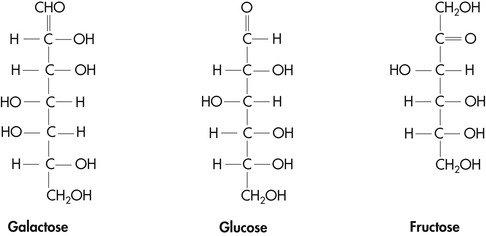Chapter 2. Carbohydrates
Carbohydrates are the major energy-containing constituents of plants, making up between 60% and 90% of dry-matter (DM) weight. This class of nutrients comprises the elements carbon, hydrogen, and oxygen. A structural classification scheme separates carbohydrates into monosaccharides, disaccharides, or polysaccharides. Monosaccharides, often referred to as the simple sugars, are the simplest form of carbohydrate. A monosaccharide is comprised of a single unit containing between three and seven carbon atoms. The three hexoses (6-carbon monosaccharides) that are nutritionally and metabolically the most important are glucose, fructose, and galactose (Figure 2-1).
 |
| Figure 2-1 |
Glucose is a moderately sweet, simple sugar found in commercially prepared corn syrup and sweet fruits such as grapes and berries. It is also the chief end product of starch digestion and glycogen hydrolysis in the body. Glucose is the form of carbohydrate found circulating in the bloodstream and is the primary carbohydrate used by the body’s cells for energy. Fructose, commonly referred to as fruit sugar, is a very sweet sugar found in honey, ripe fruits, and some vegetables. It is also formed from the digestion or acid hydrolysis of the disaccharide sucrose. Galactose is not found in a free form in foods. However, it makes up 50% of the disaccharide lactose, which is present in the milk of all mammalian species. Like fructose, galactose is released during digestion. Within the body, galactose is converted to glucose by the liver and eventually enters the circulation in the form of glucose.
Disaccharides are made up of two monosaccharide units linked together. Lactose, the sugar found in the milk of all mammals, contains a molecule of glucose and a molecule of galactose. It is the only carbohydrate of animal origin that is of any significance in the diet. Sucrose, commonly recognized as table sugar, contains a molecule of glucose linked to a molecule of fructose. It is found in cane, beets, and maple syrup. Maltose is made up of two glucose molecules linked together. This disaccharide is not commonly found in most foods, but it is formed as an intermediate product in the body during the digestion of starch.
Polysaccharides comprise many single monosaccharide units linked together in long and complex chains. Starch, glycogen, dextrins, and dietary fiber are all polysaccharides. Starch is a nonstructural plant storage polysaccharide and is the chief carbohydrate source present in most commercial pet foods. The two major forms of dietary starch are amylose (comprised of linear glucose chains) and amylopectin (comprised of branched glucose chains). Cereal grains such as corn, wheat, sorghum, barley, and rice are the major ingredients that provide starch. Glycogen is the storage form of carbohydrate in the body. It is found in the liver and muscle, and it functions to help maintain normal glucose homeostasis in the body. Dextrins are polysaccharide compounds that are formed as intermediate products in the breakdown of starch. They are created during normal digestive processes in the body and through the commercial processing of some foods. The monosaccharide units found in starch, glycogen, and dextrin molecules have an alpha-configuration and are linked together by alpha-bonds. This type of bond can be readily hydrolyzed by the endogenous enzymes of the gastrointestinal tract and yields monosaccharide units upon either digestion or chemical hydrolysis.
Although the exact definition of dietary fiber continues to be debated, dietary fiber (also referred to as nonstarch polysaccharides) comprises several forms of plant carbohydrate. The major carbohydrate components of dietary fiber include cellulose, hemicellulose, pectin, and the plant gums and mucilages. Lignin, a large phenylpropane polymer, is the only noncarbohydrate component of fiber. Plant fiber differs from starch and glycogen in that its monosaccharide units have a beta-configuration and are linked together by beta-bonds. These bonds resist digestion by the endogenous enzymes of the gastrointestinal tract. As a result, dietary fiber cannot be broken down by enzymes of the intestinal tract to monosaccharide units for absorption in the small intestine.
Although dogs and cats do not directly digest dietary fiber, microbes found in the large intestine (colon) are able to break down certain types of fiber to varying degrees. This bacterial fermentation produces short-chain fatty acids (SCFAs) and other end products. The SCFAs that are produced in greatest abundance are acetate, propionate, and butyrate. The magnitude of bacterial digestion depends on factors such as the species of animal, the type of fiber present in the diet, the gastrointestinal transit time, and the intake of other dietary constituents. Soluble fibers are those that form a viscous solution upon contact with water; it is the physical properties of these fibers that affect gastrointestinal functions such as stomach emptying time and transit time. 1 Most soluble fibers are moderately or highly fermentable in the large intestine. Conversely, insoluble fibers retain some water within their structural matrix but do not form viscous solutions. These fibers are generally much less fermentable and function to increase fecal mass and decrease intestinal transit time. For example, in dogs and cats, pectin and other soluble fibers are highly fermentable, beet pulp is moderately fermentable, and cellulose is nonfermentable (Table 2-1).
< div class='tao-gold-member'>
Only gold members can continue reading. Log In or Register to continue
Stay updated, free articles. Join our Telegram channel

Full access? Get Clinical Tree


